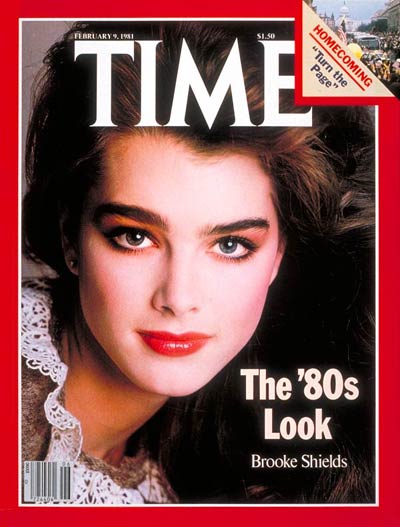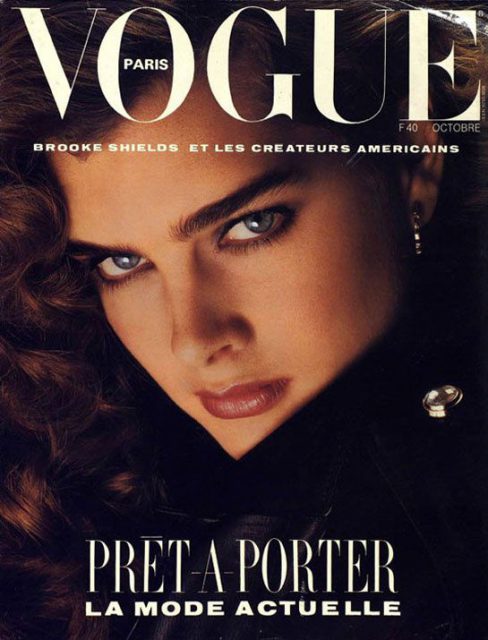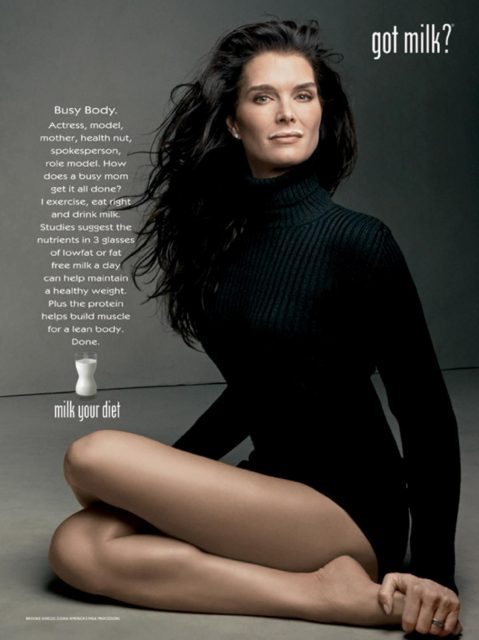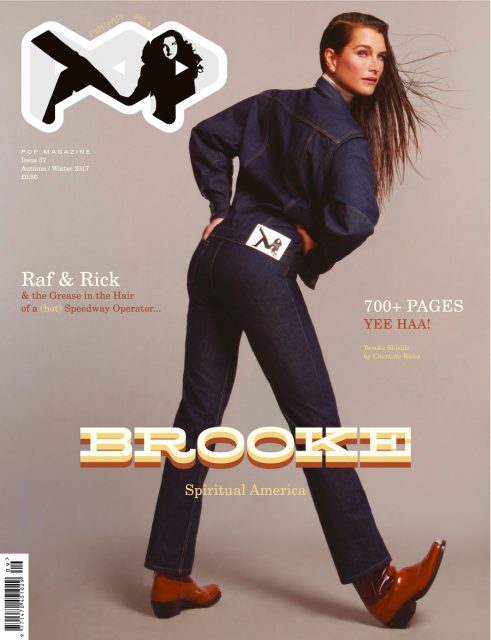Before Brooke Shields‘ eighteenth birthday she was already an indisputable part of American film lore and fashion. Her influence over the decades has spanned way beyond movies into an expansive career in fashion that is part of popular culture legend. Modeling since she was a baby, her distinctive look is a persistent reference point in fashion iconography as a favorite of Richard Avedon and Francesco Scavullo. Here the woman once named Face of the Decade tells Models.com what she really thinks about the iconic imagery she helped create.
Staying Power is an ongoing series celebrating models who have spent at least a decade working at the top of the industry. Through a selection of their most significant images, these household names and cult fashion favorites tell their stories.
Interview by Betty Sze. Text & editing by Rosie Daly

Calvin Klein Jeans, 1980
Photographed by Richard Avedon.
What’s so interesting about this is that certain photos happen and they hit the zeitgeist or they strike a chord, or it’s sort of this combination of people all in the right place at the right time. And this was by far one of those situations. You can never set out to do those photos, although people often say so now.
Because the photo itself was attached to the commercials that we were doing, it felt more of a part of a whole creative direction. It was taken out of the realm of just modeling denim and each piece was serving a bigger purpose in a way. We filmed a minute-long commercial, which was the first time a minute-long commercial had ever been filmed. We were going for a full minute and play them in movie theaters. That was unprecedented. When I look at that picture, it reminds me of a whole project that was larger than any one of the single components.
I had done big national campaigns and worked with Vogue and many European magazines. But it was the first time I was being asked to be an actress as well as a model. For me, it’s always interesting in hindsight because you look back and you look at the impact a certain image had on an industry. I never really knew what they were going to use, what they wanted, what the tone really was. This was just me and Dick Avedon working in the way that we always worked together. It was rather seamless. It didn’t seem much out of the ordinary, except for the fact that there was an actress component to it.
The more important piece was the commercials. We were doing print before and after each commercial. Sometimes we were shooting print on the set. Sometimes we were shooting it after a [commercial] spot was shot… it was over a course of three days. It felt different because it was the first time I had been asked to not just be a model but also be an actress for very different characters. This then bled back into the print version of the photo.
It was nice to feel that it had come back around to bridge the gap from photography to cinema. The DP was a film cinematographer. This was the first time that both of my worlds had been combined in one project, in one campaign.
The thing that was revelatory for me with regards to the Calvin Klein campaign was that for one product, we did multiple commercials. That one photograph…, there were two photographs that became the label and once they picked those, they kind of stuck with them. But, the commercials were so varied and it was just a different level of advertising. The copy was so different and inspiring.
We were working 14, 15 hour days for each one of those spots. It was unheard of, they didn’t have teleprompters or cue cards or anything like that. I was memorizing text that was a minute long on what the genetic code is. It was just very unique.

US Vogue, February 1980
Photographed by Richard Avedon.
There were a few years where a couple of times a week after school, I was going to Avedon’s studio and we were shooting a Vogue cover. Then I’d do my homework while Polly Mellen was doing her thing. I look at that type of a Vogue cover and I knew the look, he knew the look he wanted. It was relatively easy to do because we worked really well. I just knew him and he knew me well. So we just hammered it out. It was funny because, from the waist down, I was just in my blue jeans and Topsiders.

TIME Magazine, February 1981
Photographed by Francesco Scavullo.
The interesting thing about this cover was that we were in Italy, which was so unheard of then. I was at Valentino’s atelier and had done a private little show because I’d never done runway. The runway was maybe half the size of a table and it was just so clients could see. They didn’t have a model-model, they just had a fit model showing the clothes. I remember coming out and doing one little surprise [on the runway], it was an inside joke to do this. I walked down in this really pretty sort of hand-rolled, gorgeous silk pink, pink and black dress. At the end of it, when all the business was done, Scavullo came into the atelier and they put on a sweater, a Valentino sweater, and he set up one of the tables by a white wall. It maybe took 15 minutes. We did it just there, then, at his office on a table smashed up against the wall.
It was so shocking to me that [the cover] was such a monumental declaration. That the face of a decade … I remember laughing. I said to my mom, “mom, who decides whose face it is?” She’s said , “I don’t know. Let’s not ask any questions, just take it and we’ll just… just smile and move on.” I remember thinking, who decides this? Is it God? Who gets to arbitrarily pick somebody’s face and say that that is the face of a decade? It just was funny to me. It was an honor obviously, but it definitely didn’t feel earned as much as it felt decided by the powers that be.
The coolest thing about that cover was that I got to keep the sweater. And [usually] I never got to keep anything!

Keith Haring & Richard Avedon poster, 1985
There was a lot of pressure surrounding this. I think this was a mistake. Avedon had done the Nastassja Kinski snake poster and everybody thought this would be a brilliant idea. Keith was a friend. My mom was a huge fan of his and somehow we all, through Andy Warhol, and, Avedon, there was a combination of everybody sort of knowing each other. So Avedon thought it would be a really great idea to join forces with Keith and create a sort of equally amazing poster with the idea of, I think selling a ton of them. I assume he sold many of the Nastassja posters. Nastassja’s was so unbelievably gorgeous and unique and unseen. I think that there was a lot of pressure to come up with the next thing. But I think, when you try to do something like that, it can’t work. It doesn’t happen that way. That’s not the way I believe true, true, true art kind of emerges.
The day of the photoshoot I woke up and one eye was just practically swollen shut. I don’t know what it was, a bite or an allergy or something had gotten in my eye. We tried to cancel the photoshoot and said, unless I wear an eye patch, I’m like a pirate. Maybe that would have that might have actually been something! That might’ve been more. Now, as I think about it, it probably would have been the best way to do it. Instead, they said, we will fix her eye [in post-production]. I thought, that doesn’t seem really right, but nobody wants to give this photoshoot up. Keith had drawn these beautiful hearts and had painted them and did them specifically for this photoshoot. I thought, just do as they say. In my opinion, it just was never fabulous. It was a little bit forced. Keith was happy and sweet and we just had fun being together, but Avedon wanted to create a caption underneath it that I felt was really crude. That’s how they were going to market the poster. They were going to market it as this new, fabulous, beautifully printed horizontal poster as a follow-up to Nastassja’s and the caption was going to be ‘Brooke Shields with a heart on for Keith Haring.’ My mother took one look at that and said, “we’re not signing any release. We’re not doing anything.”, we refuse to be a part of that. Keith is a friend and it’s cheap. It’s not inspired. It’s gross.” I was only 15 or 16.
I don’t know what their justification was. I think it was to just be controversial and sell posters. I don’t think you can plan controversy just as I don’t think you can plan iconic photos. When I heard that, I thought, God, that’s distasteful. Nothing of that makes sense to me. But we did the photoshoot and they fixed the eye and the best part about it, was that we left with the artwork. My mother said, “Oh yeah? Well, they’re on styrofoam. We’re taking them.” So I have one piece over my fireplace and the other over our bed and one is dedicated to my mom. She was basically saying “we’ll take this and we’ll take this and you keep your dumb ideas to yourself” and we left–Keith and my mom and me. I think we all went downtown together.
The funny thing was, the poster itself never really sold. It wasn’t a huge success and it was because we didn’t set out to do it right. They should have postponed it to a day my eye wasn’t all swollen. It should’ve just been what it was, this collaboration of these friends and pop iconography in whatever way you want to digest that or regard it and that should have been it. Instead, I think they were just trying to do too many things. In any case, it was not a success and I wasn’t surprised.

Vogue Paris, October 1984
Photographed by Albert Watson.
I always loved working with Albert Watson. I was friends with his son and we went to school together, and Albert always was able to take a big magazine like that and shoot it so that it still seemed like it retained a bit of me. Avedon was always just a little bit more in-your-face about something, a little bit more arch. He always wanted this sort of surprised look. With Albert, he has such a good sense of humor, always has. Our friendship was always so good. There was a warmth to it. I always felt very pretty when I worked with him. Different than when I worked with Avedon… or Scavullo, who had a different kind of a thing too because it was Cosmo or whatever. Also, I’d known him … he shot my first Ivory soap ad when I was 11 months old, so I had known him my whole life. But Albert always seemed, it just always was sort of luscious and I always felt like you knew you were going to be sort of the prettiest and glamorous, but not too forced.

Cosmopolitan US, February 1981
Photographed by Francesco Scavullo. Beauty by Way Bandy.
This was my first Cosmo and this was also with Way Bandy. I remember thinking I was going to be too flat-chested for it, but because we got this keyhole on the leather, I was able to borrow it that night and go to a premiere. I wore a blazer over it, a big white blazer, and it was very exciting. I felt like I had really made it because I was grown up now enough to be on the cover of Cosmo.

Vogue US, April 2003
Photographed by Annie Leibovitz.
I remember being worried that I didn’t look pregnant enough for the timing of the magazine so I had to kind of puff out my stomach. I knew that no pregnant photo was going to rival Demi’s because hers was so extraordinary. We did this whole day underwater, and we were underwater in a tank. We had such high hopes about what this photo was going to be and… it just didn’t work. It just wasn’t what [Annie Leibovitz] wanted. We just didn’t succeed at it. We were so frustrated because it just wasn’t what we’d hoped. We pictured water and pregnant and all of the references you can make. At the very, very end, I stood out of the pool, and I remember thinking, “Oh God, this is probably going to be the one that they use” and it sure was. It was the one where I got out of the pool and [Leibowitz], said “stay there for one second.” That was it. That was the photo.
We really tried. It could have been great, but that’s if it wasn’t as forced as it was. We were really battling water and timing and the dress was on my face. It was not easy to do and it was really hard to hold my breath that long.

Got Milk? campaign
Photographed by Annie Leibovitz.
I worked with Annie again to do the Got Milk? one. She wanted me to wear a turtleneck and at first, I thought, nobody’s done a milk ad nude. Why don’t I just do it naked and just covered, but have it be nude? I thought it would be cool. And obviously, that’s why I’m not a photographer and she is. She said, “no, we’ve got your legs. That’s what I want and then I want it all to be about the face.” She just sort of wanted the body to kind of go away. We shot that in LA while I was doing Suddenly Susan at the time.

MAC Cosmetics, 2014
Photographed by Inez and Vinoodh.
The Inez and Vinoodh thing was so hysterical to me because we’re doing this MAC palette that was both night and day and two sides of a person. I had never worked with a pair of photographers. I was used to zeroing in on a photographer and you understand their movements and their vernacular and their tone and the environment is different. It’s a very personal thing and it’s in the lens and it’s just you and just them, but here they were a couple together. They hired a choreographer [Stephen Galloway] to stand behind the camera and emote. I could hardly keep a straight face. It just seemed so unbelievable to me. It was great. He is extremely lyrical and beautiful and that’s what he does. He is this beautiful man. It just struck me as the funniest thing I’d ever seen. I just had never worked like that before. I thought, what am I supposed to do with that? Why is he doing all that behind the camera? It was really funny to me. Inez and Vinoodh have such a fascinating sensibility. I have worked with them more than once, and would like to do so again!

Pop Magazine, Winter 2017
Photographed by Charlotte Wales.
It was so incredible when they asked me to come back on board with Calvin and be a part of the label again. This video, sort of retro kind of homage, it was just an honor. It was just cool to be a part of it and have the old images be resurrected in such an interesting way. It was fun. I just remember thinking, “yeah, I’m probably the only one that can do this, I guess.”







